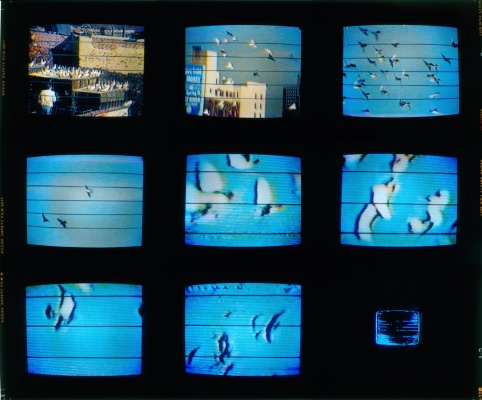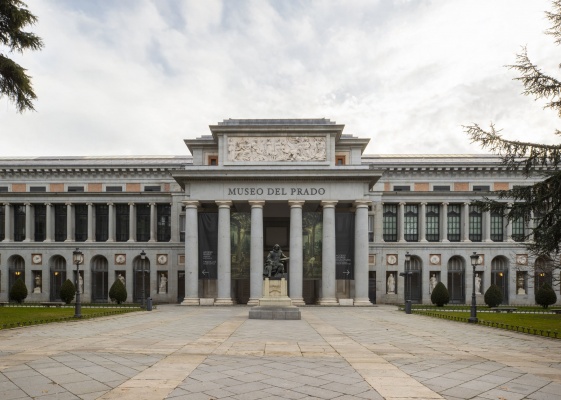Descripción de la Exposición
Why call “silence” an exhibition that has so much to say? Eight paintings and a set of objects compose Magdalena Jitrik’s fourth solo exhibition at Galeria Luisa Strina. It is as an enigma to be deciphered. Perhaps the most mysterious of the paintings, which at first sight appears to be the representation of a pair of eyes on a red concrete bulky formation, evokes the glances cast by the seated female figure in the lower right corner of Les Demoiselles d’Avignon, as well as the dying woman, outstretched arms in a surrendering posture, on the right side on the Guernica painting. The reference to Picasso is not direct nor fundamental, but it is known that the Argentine artist uses historical vanguards, from cubism and surrealism to the De Stijl and Bauhaus, in her critical reinterpretation of modernisms.
The resemblance to Picasso´s paintings is due less to the work by the Spaniard than to Picasso’s appropriation of primitivism, after all, the aesthetic choice to abandon perspective in favor of the two-dimensionality was deliberately adopted in Les Demoiselles in order to “épater la bourgeoisie”, who was used to traditional European painting, is revised by Jitrik in her deliberate use of perspective. In her paintings, Magdalena usually inserts visual contradictions between background and figure. The smoky effect on several of the pictures presented in El Silencio produces not only a sensation of a floating volume, but also projects the figure back and forth in an infinite dynamism.
It is important to remember that in 1907 Matisse classified The Young Women of Avignon as a bad taste joke, and today the painting is considered the genesis of the Cubist revolution. On one hand, if Les Demoiselles founded cubism, Guernica is the movement’s greatest icon. As it is known, the title of Picasso’s monumental painting derives from the name of the Spanish village that was the first urban area to undergo aerial bombing on April 26, 1937, by the German military air force that backed up the Francoist dictatorship during the Spanish Civil War, prologue to the Second World War. Nowadays, and over the years since then, this work is considered a peace symbol and a libel against war atrocities, of any war. It is said that when a Nazi official saw the painting, he allegedly asked Picasso: “Did you produce this horror, sir?”, To what the artist replied “No, you did”.
Magdalena Jitrik’s exhibition can be thought as a manifesto against the archipelago of arrogance that condemns us to silence. The more geometric works of the show have a Mondrian felling to them, who is also revisited in a sideway manner, logically. It is symptomatic that the pieces assembled in the gallery shed light to the Manifesto I (1918), by the group De Stijl to the present, a century and two great wars later:
There is an old and new understanding of time. The old one is related to the individual. The new one is related to the universal. The dispute between individual and universal is shown both in global wars and in contemporary art.
War is destroying the old world and its content: predominance of the individual in all fields.
The new art has brought to light what is contained in the new understanding of time: a balance between the universal and the individual.
The new understanding of time is prepared to take place in both the inner and outer life.
Tradition, dogmas and the predominance of the individual (of the natural) are preventing this understanding.
Therefore, the founders of the new plastic arts ask everyone who believes in the reform of art and culture to annihilate these development obstacles, just as they annihilated in the new plastic arts (abolishing natural forms) what prevents any pure artistic expression, the ultimate consequence of all art forms.
Current artists, driven by the same consciousness throughout the world, took part in the world war against the domain of individualism and authoritarianism from an intellectual point of view. They commiserate, then, with all who fight, intellectually or materially, for the formation of a life union, in art, in culture.
The war against individualism, in Jitrik’s career, is perhaps most evident in her militancy ahead of the Popular Workshop on Screen Printing, with Mariela Scafati and Diego Posadas, in the year 2000. With this collective, for example, the Argentine took part in the 27th Bienal of São Paulo in 2006 curated by Lisette Lagnado – an exhibition that disseminated the concept of relational aesthetics by the Frenchman Nicolas Bourriaud in Brazil and is now considered a turning point in the history of the Biennial, firstly by abolishing national representations, but mainly for having placed on the agenda of the art system the artists´ researches that focused on collaboration and cohabitation, or else, on the values of “living together”, which was borrowed from Roland Barthes´ work, that was the expression that gave the 2006 Biennial its name, Como Viver Junto. The union that the artists fought for a century ago was revived in Latin America and around the world in the year 2000 and again, at the beginning of the following decade, in the Arab Spring (2011) and in the Days of June, in Brazil (2013).
Let’s return to the painting that seemed to portray a pair of eyes and see there two birds that touch each other with the tip of their beaks, two people who are in dialogue, or yet the symbol of infinity. “It was a picture where visuality and materiality emerged, somewhat arbitrarily, in the process of producing the works for the solo show at Luisa Strina. I do not have a lot to say about this work, unless I see in it something about communication, communication as a symbol of something continuous, something infinite, “reflects Magdalena Jitrik. The artist´s show tells us, in the end, that, even when we cannot speak, silence promotes the reflection that leads to an infinite conversation with the other.
ABOUT THE ARTIST
Magdalena Jitrik (1966) was born in Buenos Aires, where she lives and works. From 1974 to 1987, the artist lived in México, where she studied visual arts at Escuela Nacional de Artes Plásticas. She has been showing her work since 1990, when she had her first solo show at Galería del Rojas. She was one of the founders of the Argentine art collective Taller Popular de Serigrafía (2002 -2007), with whom she created an intervention of graphic art in the 27th Bienal de São Paulo (2006). Jitrik has joined the biennials of Porto Alegre, Brazil (2009); Thessaloniki, Greece (2009); Trienal Poligráfica de Puerto Rico (2009), Istambul, Turky (2011) and Manifesta 9, Genk, Belgium (2012).
Recent solo exhibitions include: Venceremos // Black is Beautiful, Centro Cultural Universidad Nacional General Sarmiento e Casa Doblas, Buenos Aires, Argentina (2017); Vanguardia – America, MACBA, Buenos Aires, Argentina (2016); Modern Painting, Galeria Luisa Strina, São Paulo, Brazil (2014); El Fin, el Principio, Fundación Universidad Di Tella, Buenos Aires, Argentina (2013); International Lantern, The Beltable Center, Limerick, Ireland (2012); La Linterna Internacional, Museo Castagnino, Santa Fe, Argentina (2012).
Recent group shows include: Potência e Adversidade – Art from Latin America at the collections of Portugal, Museu de Lisboa / Pavilhão Branco and Pavilhão Preto, Lisboa, Portugal (2017); Verboamérica, Museo de Arte Contemporáneo de Buenos Aires (2016); Retour sur l’Abîme – l’art à l’épreuve du génocide, Les Musées de Belfort, France (2015); El teatro de la pintura, Museo de Arte Moderno, Buenos Aires (2014).
Public Collections holding her work include: MACBA Barcelona; Reina Sofia, Madrid; Museo de Arte Contemporáneo de Rosario (MACRo), Rosario, Argentina; Museo de Bellas Artes de Bahía Blanca, Argentina; FRAC – Provence-Alpes-Côte d’Azur, Marseille, France; Fundación ARTEBA, Buenos Aires; MALBA – Museo de Arte Latinoamericano de Buenos Aires; Centro de Arte 2 de Mayo, Madrid, Spain; Museo Universitario de Arte Contemporáneo, UNAM, México.

Actualidad, 11 jun de 2019
#loquehayquever en Argentina: el arte está en el sur
Por PAULA ALONSO POZA
BIENALSUR 2019, bienal organizada por la Universidad Nacional Tres de Febrero (UNTREF), acaba de abrir sus puertas. Durante medio año, las 112 sedes de los 21 países participantes ofrecerán acciones y exposiciones de forma ...

Exposición. 08 may de 2025 - 14 sep de 2025 / MNAC - Museu Nacional d'Art de Catalunya / Barcelona, España

Formación. 30 oct de 2025 - 11 jun de 2026 / Museo Nacional del Prado / Madrid, España